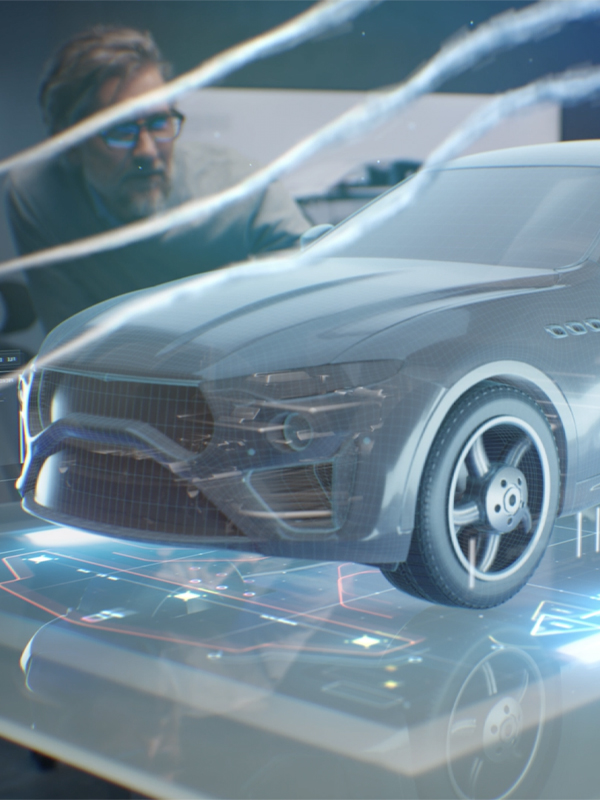Key Takeaways
- Extended reality (XR) technologies, including virtual, augmented, and mixed reality, have been gaining attention in the automotive industry for their potential to disrupt and transform.
- XR technology allows designers and engineers to visualize and simulate vehicle designs before physical production.
- This technology also has benefits for sales and onboarding processes for both customers and employees.
- Aquent has recognized the potential of XR in the automotive industry and has established an XR Automotive Practice to guide clients through its implementation.
The narrative is all too familiar: emerging technologies arrive with the promise of industry disruption and transformation. Extended reality (XR) technologies, encompassing virtual, augmented, and mixed reality, have been caught in this cycle of hype. Yet, speak with industry leaders at GM and Stellantis, and you'll hear a different story. For them, XR technologies are not just buzzwords; they are disruptive technologies—actively being explored for applications in design and development, education, onboarding, and sales. At Aquent, we're working alongside our clients to navigate this promising future, developing technologies that edge us closer to an immersive automotive experience.
A new era of extended reality

In 2013, Oculus ushered in a new era of spatial computing with the release of the Oculus Rift DK1 headset, opening up seemingly endless possibilities. The worlds of gaming and high-fidelity simulation began to merge, prompting game engine companies like Unreal Engine and Unity to develop feature sets for creating immersive games and simulations. Since then, we've made significant strides, with companies like Meta, HTC, and, more recently, Apple developing increasingly sophisticated headsets.
Where is the spatial computing industry headed? Apple and others see the future in augmented reality (AR), with mixed reality (MR), as the next significant step forward. Currently, AR technology hasn't fully matured, making MR the optimal choice. MR allows us to view the world through high-resolution screens that seamlessly integrate virtual content, offering a glimpse into the vast potential of AR development. This technology enables us to overlay digital information onto our physical environment, and with advancements in machine vision and artificial intelligence, we're moving closer to a future where spatial computers can accurately interpret and interact with the world around us. This evolution promises an exciting and transformative future across many industries.
The possibilities for XR in car design and manufacturing are endless—bounded only by our creativity and expertise. The Apple Vision Pro, for example, has dual 4k screens that make it feel like these synthetic cars are really in the scene with us. Add to that a lidar laser to scan the world around you, and you can create “scene awareness” so you can blend real and virtual worlds together more seamlessly. Apple's latest SharePlay feature will allow remote sessions in Avatar so designers can explore an automotive design together. It is not hard to imagine then what that means for multinational corporations where business units are scattered across continents. This is a unique moment for spatial computing and a disruptive moment for the automotive industry.
Revolutionizing automotive design with XR technology
XR is a transformative technology within the automotive industry, granting designers and engineers the ability to visualize and simulate their creations long before the physical manufacture of a vehicle. This is akin to the revolution brought about by wind tunnels, which were later supplanted by digital simulation in aerospace design. A similar evolution is now unfolding in the automotive sector.
Creating virtual car models with XR technologies allows quicker design iterations, evaluation, and validation of designs backed by robust data analytics. Imagine, for example, that a User Experience (UX) Engineer is designing a new generation of infotainment screens and controls. The engineers can now utilize a virtual model of the car, allowing users to test the intelligent cruise control. Engineers can gather comprehensive analytics on the users' gaze, hand placement, and head positions. All of this is achieved without the need to construct a physical car or a car mock-up. This can now be done at a fraction of the cost and quicker than some traditional design and development methods.
Spanning the entire product lifecycle

XR for automotive spans the entire product lifecycle, from design and development to sales and onboarding. XR-assisted design affords teams the ability to bring multiple ideations to life more rapidly. This has always been a struggle inside automotive studios. Generally speaking, a team is assembled, they begin a sketch charrette, and then stakeholders and customers look at the results and provide feedback. Ultimately, the teams zero in on a few concepts to build full or partial-scale models. This can be an incredibly time-consuming process, taking up to several months to complete. Tools like Gravity Sketch have evolved this process to become quicker by essentially allowing designers to create surfaces in 3D space and visualization technologies like Apple Vision Pro and HTC Vive are starting to unlock greater efficiencies in design review and product selection.
This is not only affecting the industrial design timelines positively but also the digital UIs of the vehicle as well. XR tools enable designers to rapidly prototype, simulate, and iterate digital interfaces for the car’s Human Machine Interface (HMI) in immersive virtual environments. Design teams can quickly sketch and visualize multiple HMI concepts in three dimensions, allowing for more efficient exploration of design variations and interaction models. Stakeholders and customers can provide feedback on virtual prototypes in real time, accelerating the decision-making process and reducing the need for costly physical mock-ups and prototypes. As a result, digital design iterations within car HMIs can be completed in a fraction of the time compared to traditional methods, leading to faster concept validation and refinement.
Customer Experience and Software Defined are important area of focus as the demographics, dealership models, and vehicle ownership are evolving. Manufacturers are putting more and more content inside of vehicles and not always for the betterment of the customer experience, let alone making the roles of the dealer and onboarding team more challenging. As digital trends around Software Defined Vehicles (SDVs) continue to evolve, we are presented with opportunities we have not experienced in the world of automotive before. The Software Defined Vehicle (SDV) not only revolutionizes the automotive industry but also prioritizes customer experience (CX) through advanced software technologies, with Extended Reality (XR) playing a pivotal role even before products hit the market. XR enables consumers and businesses alike the opportunity to gain deeper understanding before products come to market. In a world that is becoming more and more autonomous and personalized, it is critical that we bring situational awareness of what this new era of vehicles is capable of in the safest ways possible. This approach ensures that SDVs are finely tuned to meet the diverse needs and preferences of drivers and passengers, ultimately enhancing CX from the design phase to the road.
In today's evolutionary automotive landscape, Extended Reality (XR) stands as a complementary solution within the portfolio of existing processes and technologies aimed at alleviating pain points and amplifying delight within the automotive industry. XR should complement traditional methodologies and enrich them with immersive experiences such as virtual test drives and product configuration. Rather than replacing established practices, XR augments them, offering a new dimension of engagement and efficiency. For instance, while physical showrooms remain pivotal, virtual showrooms powered by XR add a layer of convenience and personalization, allowing customers to explore and customize vehicles from anywhere. Similarly, in the realm of design and development, XR tools supplement conventional prototyping methods, enabling faster iterations and more informed decision-making. By embracing XR as a complementary solution, automotive businesses can streamline processes, mitigate challenges, and elevate customer experiences, ultimately fostering a harmonious blend of innovation and tradition in the pursuit of automotive excellence.
Aquent's XR Automotive Practice: driving the future
At Aquent, our vision is to guide our clients in an emerging technology field that requires a vision of how XR technologies can impact the automotive industry. Hence, our newly formed XR Automotive Practice was created to address this niche. Led by Will Thompson and Giovanni Castillo, this group comprises Technologists, Engineers, UX Designers, and Spatial Computing Specialists. Our vision is to address the full automotive product cycle by implementing an XR strategy from design to onboarding and education, to showroom and sales. This is a disruptive technology for the automotive industry, and Aquent is committed to realizing its full potential for our clients.






